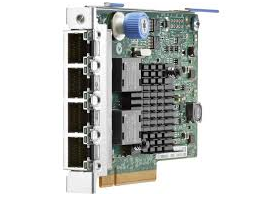Product Details
The HPE Ethernet 1Gb 4-port 366FLR features the next generation of Ethernet integration offering in a single chip solution on a FlexibleLOM form factor, further reducing power requirements for 4 ports of 1Gb Ethernet. The HPE 366FLR is the PCI Express 2.1 x4 based on the latest Intel® Ethernet Controller I350 designed for use with select HPE ProLiant Gen8 rack and scalable servers. Its FlexibleLOM form factor means customer now have choice to meet growing infrastructure needs.
The HPE 366FLR adapter supports advanced features such as Large Send offload capability, TCP checksum and segmentation, VLAN tagging, MSI-X, Jumbo frames, IEEE 1588, and virtualization features such as Intel Virtualization Technology for Connectivity, Microsoft VMQ and WOL, and power management technologies like Energy Efficient Ethernet.
Benefits
- 4-port 1Gb Ethernet PCIe Gen 2.1, x4 lane adapter designed for maximum network performance
- SR-IOV ready virtualization capabilities with support for Microsoft VMQ , Intel VT-c helps meet the performance demands of consolidated virtual workloads
- New I/O technologies reduce system power, increases I/O performance and reduces I/O latency. Supports Precision Time Stamping protocol (IEEE 1588 and 802.1AS)
- Supports Wake-on-LAN (WOL) at 1Gb, has PXE , MSI-X support, Teaming, IPv6
- Adapter supports HP Sea of Sensors 3D Technology
Features
- 4-port PCIe 2.1, x4 lane 1Gb FlexibleLOM adapter based on Intel® Ethernet Controller I350 for select HP ProLiant Gen8 Rack and Scalable servers
- Optimized for virtualization with VMDq and SR-IOV in Microsoft VMQ, Xen and Linux environments
- New I/O technologies increase performance and reduce system power and I/O latency
Screenshots







